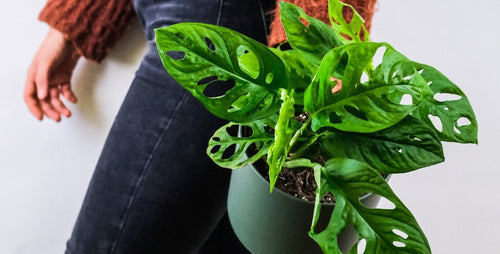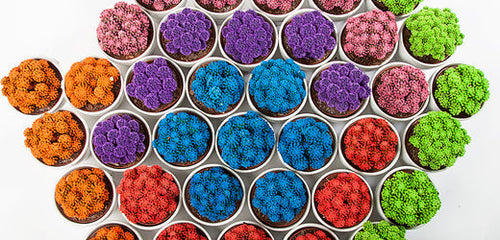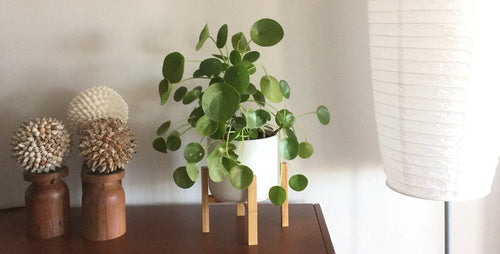
Lemon Button Fern
The old expression “cute as a button” takes on new meaning with Lemon Button fern. These charming little plants produce golden-green fronds lined with small, button like leaflets. When gently rubbed or brushed the fronds give off a slight lemony scent. Lemon Button fern is a small fern, rarely growing over 10 inches tall, making it ideal for terrariums, windowsills, or bathrooms.
Silver Lace Fern
The lacy, variegated foliage of Silver Lace fern looks terrific in any setting. Just keep these beauties slightly moist and they’ll add a fresh look to almost any room in your house. Eventually Silver Lace fern can grow 16 feet tall, but most of the time they’ll stay pretty compact so you can tuck them into pint-sized pots. Just make sure the pot has at least one drainage hole in the bottom.
Bird's Nest Fern
Unlike other ferns with frilly foliage, Bird’s Nest develops large, shiny leaves that branch out from a central point making the plant look a bit like a bright green bird’s nest. The attractive foliage can also be smooth, crinkly, or wavy. Bird’s Nest fern prefers slightly moist soil, but it is more tolerant of drier conditions than other varieties. Over time, Bird’s Nest fern can grow 2 feet tall indoors.
Mahogony Fern
There’s no mistaking a Mahogany fern. The new growth of these amazing ferns starts out as a rich reddish brown tone, providing a pretty contrast to the older, bright green foliage. Mahogany fern also prefers brighter light than other species and will do well in the brightest rooms in your house. It likes high humidity, too so mist frequently or set your plants on some gravel in a water filled tray.
Staghorn Fern
Talk about a conversation piece! Staghorn ferns don’t grow in soil so they are often mounted on a board where they develop masses of large, antler-like fronds. Young plants are often sold in pots, but as they get larger they need to be mounted. Care is easy. Just soak the plants in tepid water once a week during the summer and twice a month in winter. Misting both sides of the leaves also helps. Staghorn ferns prefer bright, indirect light, but no direct sunshine. Feed with a dilute liquid houseplant fertilizer once a month.
Rabbit's Foot Fern
Offering a combination of pretty foliage AND interesting roots, Rabbit’s Foot fern is doubly fascinating. These easy-care ferns develop gorgeous, lacy fronds atop fuzzy creeping rhizomes (surface roots) that will slowly spill over the side of the pot. There are two main kinds of Rabbit’s Foot ferns—White and Black. They look a lot alike except for the fact that one develops black rhizomes and the other has white. Both prefer slightly moist soil, but are fairly forgiving about dry soil.
Austral Gem Fern
At first glance you might think that the thick, almost waxy fronds of Austral Gem fern were made of plastic. Yet, these thick fronds are what makes this super easy fern is a joy to grow. In fact, the waxy fronds help the plant conserve moisture if you happen to forget to water every now and then. Austral Gem fern thrives in low to medium light and will eventually grow 12 inches tall and wide.
Fluffy Ruffles Fern
A smaller, denser version of Boston fern, Fluffy Ruffles is so darn cute you’ll have to stop yourself from petting it every time you walk by. Fluffy Ruffles rarely grows over 12 inches tall so it fits well in bedrooms, bathrooms or even larger terrariums. Unlike larger Boston ferns, Fluffy Ruffles is fairly tidy, rarely dropping leaflets all over your floor. As long as you keep it away from direct sunlight, your Fluffy Ruffles fern should thrive.
Kangaroo Fern
Add impact to any room of your house with Kangaroo fern. These gorgeous Australian natives show off densely packed, dark green, ribbon-like fronds that often fold and trail over the pot’s edge. Plus, as the plant matures, it develops fuzzy stems (rhizomes) that slowly creep over the surface of the soil. Kangaroo fern prefers slightly moist soil at all times. It can grow 1 to 2 feet tall and wide.
Caring for Your Indoor Fern
Lighting
To keep your indoor ferns in top form, place them in a location that receives bright, indirect light—they won’t survive in total darkness. A window that receives a little early morning or late afternoon sun is perfect. Avoid putting them in direct sunlight or they may fade or scald. During the summer, consider giving your ferns a summer vacation outdoors. Place them in a shaded location that’s protected from high winds and water whenever rainfall is scarce. Bring your plants back indoors in the fall before nightly temperatures start dropping below 50 F.
Soil and Water
Ferns also prefer rich, slightly moist soil. Water whenever the soil feels just barely dry to the touch, but don’t over do it, these beauties aren’t happy in constantly wet soil. Indoor ferns also prefer humid conditions, especially during the winter, so mist them regularly with warm, soft water. It’s also smart to locate them in a bathroom or kitchen where they’ll benefit from the extra moisture in the air. You can also try setting your ferns on a tray of wet pebbles. Smaller specimens will also thrive in terrariums.
Feeding
During the summer, feed your ferns with a dilute solution of liquid houseplant fertilizer once or twice a month. A drop or two added to the water is all you need to keep them happy. There’s no need to fertilize ferns in the fall and winter.
Discover more varieties of indoor ferns.
Learn more with our indoor fern guide.

















